This section will explore the transactions of the Accounts payable module; transactions are divided into two main categories, invoicing and payment:
- Invoicing: This is divided into purchase-order-related invoices and nonpurchase-order-related invoices:
- The purchase-order-related invoices: These invoices represent the invoices that are normally attached to a purchase order(s). Invoices related to a purchase order can be the final invoice of the purchase order, which is received after delivering the goods, or the prepayment invoice, which is recorded before delivering the goods. The attached prepayment invoice to a particular purchase order is a new functionality released in Microsoft Dynamics AX 2012.
- The nonpurchase-order-related invoices: These invoices represent the vendor liabilities for services rendered to the company; there are two types of recording service invoices. The first is noninventory invoices, which are related to nonstockable items and are commonly used by the company departments to record their expenses. The other type is the invoice journal for services, which is posted directly to the expense account; it is commonly used by accountants.
- Payment: The second category is the vendor payment. There are two types. The first is a prepayment transaction, which is considered as vendor advances. This can be assigned to a particular purchase order, or need not be assigned to a purchase order. The second type is the vendor payment, which is settled against the vendor invoice.
The categories are summed up in the following diagram:

The purchase order invoice document can be posted from two different forms; the first form is the purchase order form, and the second form is the vendor open invoices.
Open the vendor invoices form. This is a new function in Microsoft Dynamics AX 2012. This form is used also for nonpurchase order invoices.
In order to post a purchase order invoice from the purchase order form, navigate to Accounts Payable | Common | Purchase orders | All purchase orders after choosing the required purchase order, then go to the Invoice ribbon and navigate to Generate | Invoice. The following screenshot illustrates the Purchase order invoice menu:

In the vendor invoice form, the purchase order and product receipts are retrieved automatically; then, enter the invoice number and description. Click on Post to generate the invoice transaction. The following screenshot shows the vendor invoice form:

The relation between the vendor invoice, product receipt, and purchase order is that the purchase order has more than one product receipt and the invoice can cover one purchase order with more than one product receipt. In some business cases, the vendor invoices cover receptions that occur on more than one purchase order.
The following diagram illustrates the relation between the purchase order, product receipt, and invoice:
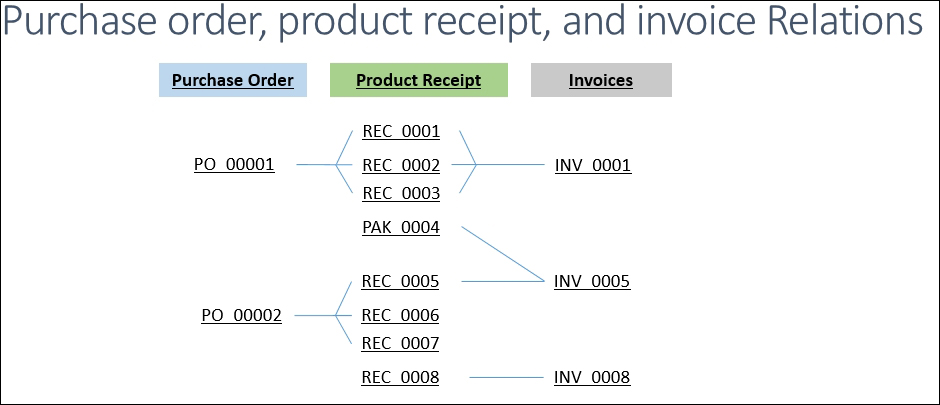
This business scenario can be managed on Microsoft Dynamics AX 2012 R3 in several ways. The following section illustrates the most common functionalities to post an invoice that covers more than one product receipt or purchase order.
Navigate to Account Payable | Periodic | Maintain vendor invoices on the vendor invoice form under the Vendor invoice ribbon; there are two options there, whether to retrieve the product receipts or the purchase order, as shown in the following screenshot:

The first option, From purchase order, opens the filtration query, as shown in the following screenshot. The user can retrieve information based on values on the query; this can be a product receipt, vendor ID, and so on.
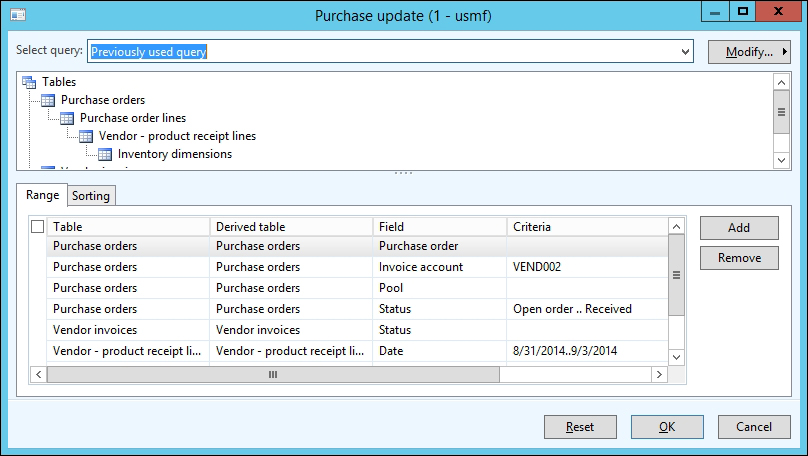
As shown in the following screenshot, two lines have been retrieved according to the entered query, that is, two purchase orders with two different product receipts. This represents two different invoices for each line.

In order to consolidate the two invoices in one invoice document, go to the Maintain ribbon and select Consolidate invoice. Now, select Consolidate invoices. The following screenshot illustrates the consolidate option:
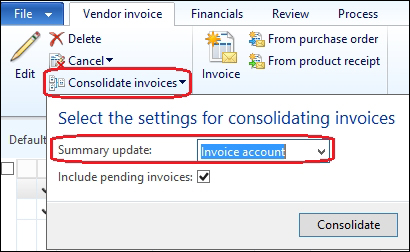
Note
The Summary update dropdown has four options, as follows:
None: There are no summary updates.
Invoice account: Summary update all selected orders according to the criteria set in the Accounts payable parameters or Summary update parameters form.
Order: Summary update a selected range of orders into, for example, one invoice. The orders will be summary updated according to the criteria set in the Accounts payable parameters or Summary update parameters form.
Automatic summary: Summary update all selected orders automatically according to the criteria set in the Accounts payable parameters or Summary update parameters form.
The second option, From product receipt, lists all product receipts and their lines. As represented in the following screenshot, the marked product receipts will be included in the vendor invoice. In order to go to the Product receipt form, navigate to Accounts Payable | Periodic | Maintain vendor invoice | New ribbon | From product receipt.
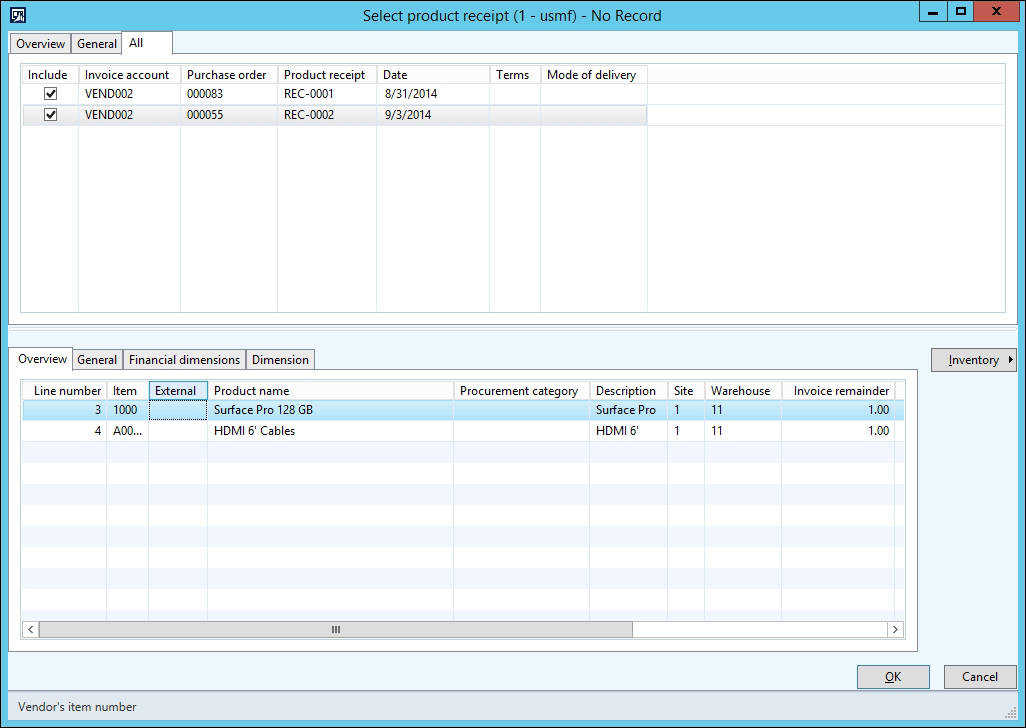
There is another functionality that can be used to post one vendor invoice for multiple purchase orders or product receipts. Navigate to Accounts Payable | Common | Vendor Invoices | Open vendor invoices, create a new record, and enter the invoice number and description. Then, go to Retrieve purchase orders under the ribbon.
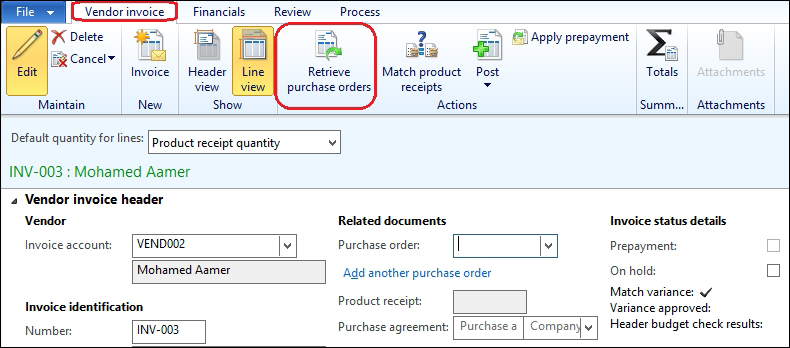
As shown in the following screenshot, a list of purchase orders with their product receipts is shown in this form. The user can mark which product receipts will be included in the invoice.
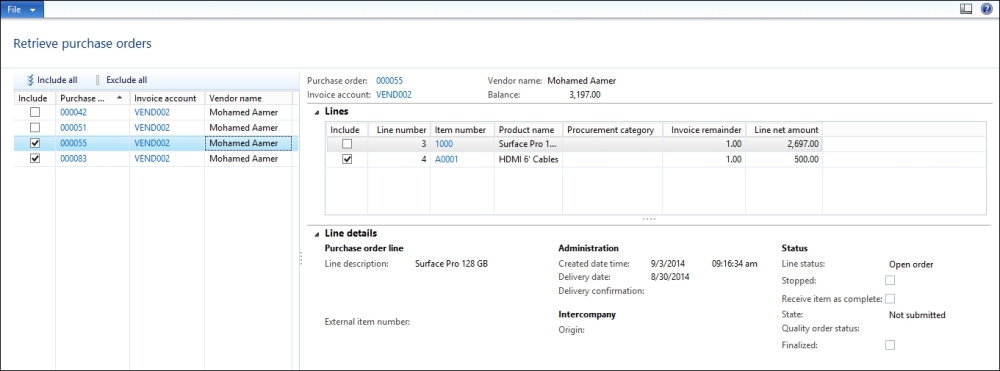
The following screenshot shows that the invoice-related documents are multiple and are on the lines of the relation between the purchase order and product receipt:
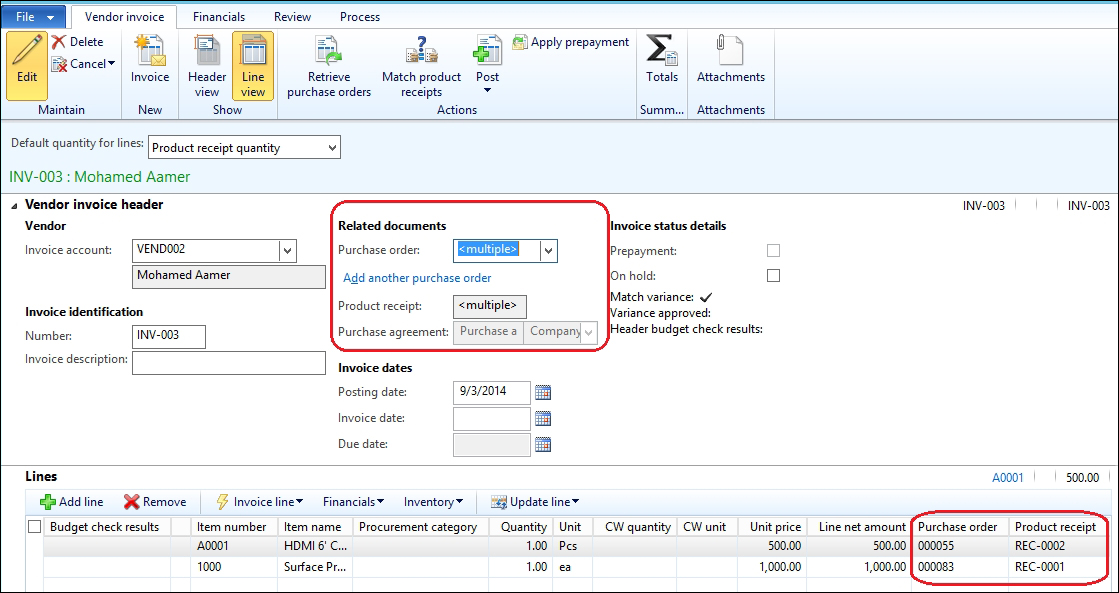
In order to inquire about the vendor balance, navigate to Accounts Payable | Common | Vendors | All Vendors and click on the Balance ribbon. As shown in the following screenshot, the balance form shows the current vendor balance:
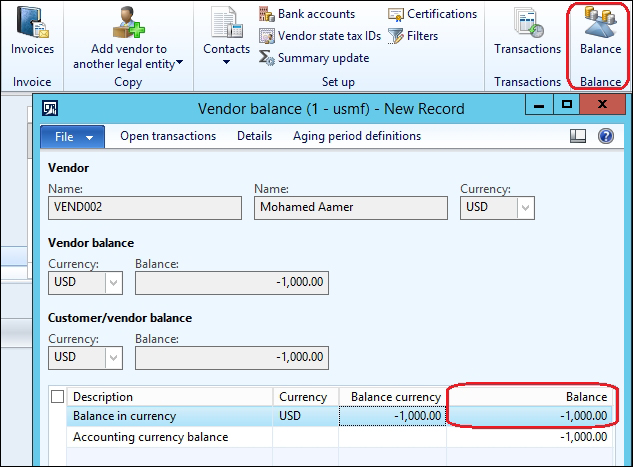
The purchase order invoice automatically generates the liability financial entry based on the vendor posting and inventory posting profiles. The inventory posting profile must be carefully structured during the design phase where the controller should understand the mechanism of invoice posting well.
The generated invoice entry is divided into four lines; two entries represent the produce receipt entry reversal, and the other two entries represent the vendor liability entry:
- The financial entry of a product receipt is enhanced in Microsoft Dynamics AX 2012 R3 to be a two-liner entry as follows:
- Dr. Product receipt account
- Cr. Vendor accrual account
- The other two entries represent the vendor liability as follows:
- Dr. Vendor accrual account
- Cr. Product receipt account
- Dr. Purchase inventory receipt
- Cr. Vendor balance
The prepayment invoice function is not covered in the previous versions of Microsoft Dynamics AX. The vendor prepayment function gives a company's controller the ability to minimize the risk by applying the segregation of duties between company departments and control prepayment process, where accounts payable does not perform the prepayment transaction without assigning the prepayment linked to the purchase order and harmonizing the business process between procurement and accounts payable. Assume that the company has agreed with a vendor to supply goods to the company and the vendor has a condition to receive a prepayment before executing the goods delivery, and this is a normal practice in the daily business.
The vendor prepayment cycle is executed among the procurement agent, accounts payable, and bank accountants. The following diagram illustrates the business process of the prepayment:
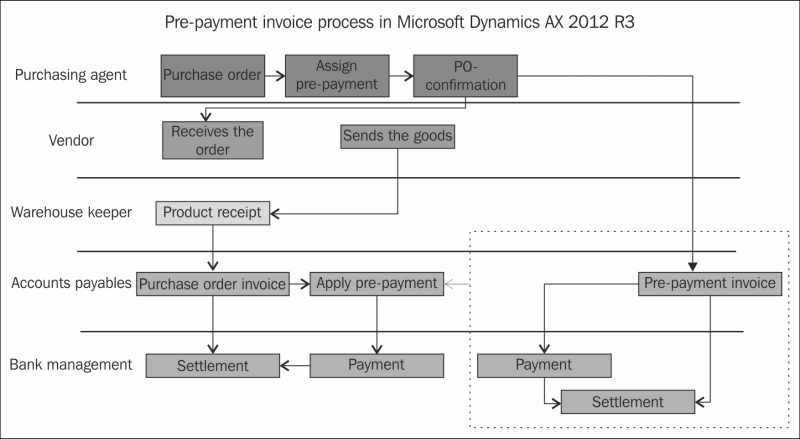
From the preceding diagram, we can see that:
- The procurement agent creates a purchase order
- The procurement agent assigns the prepayment to a purchase order as per the agreement with the vendor; here, the prepayment is a fixed amount or a percentage from the total purchases of the PO
- The procurement agent confirms the purchase order
- The vendor issues a prepayment invoice
- The Accounts payable accountant posts the prepayment invoice, and the prepayment invoice amount is inherited from the previous prepayment assignment
- Bank accountants have open invoices that need to be paid and settled against the payment
- After the warehouse keeper receives the goods in the warehouse, the vendor sends the final invoice
- The accounts payable accountant applies the prepayment to the final invoice and posts the PO invoice. If the AP accountant does not apply the prepayment invoice to the PO invoice, they can apply it later on
- The bank accountant opens the invoice with a vendor residual balance that needs to be paid and settled against the payment
In order to assign a prepayment invoice on a created purchase order, navigate to Accounts Payable | Common | Purchase orders | All purchase orders. Navigate to Purchase | Prepayment, as shown in the following screenshot:

The prepayment form will pop up as shown in the following screenshot; enter the prepayment description, select whether the prepayment will be Fixed or Percentage from the purchase cost, and select the procurement category:

As shown in the following screenshot, navigate to Invoice and select Prepayment invoice in the purchase order form:

Then, post the prepayment invoice from the vendor invoice form, as shown in the following screenshot, and enter the invoice number and description:
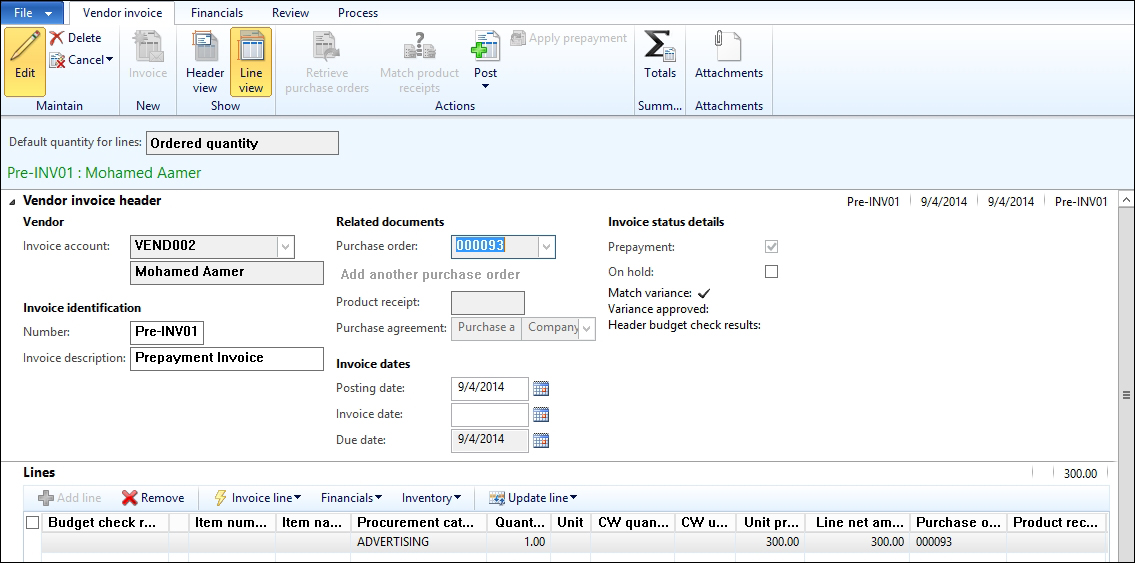
The financial entry is automatically generated based on the inventory posting profile as follows:
- Dr. Prepayment
- Cr. Vendor balance
At this point, there is a liability on this particular vendor with the prepayment amount, and this liability appears in the open transactions, which are not settled yet. This form is Settle open transactions; in order to access this form, navigate to Accounts Payable | Common | Vendors | All vendors, select a particular vendor, then go to the Invoice ribbon and select Settle open transactions, as shown in the following screenshot:
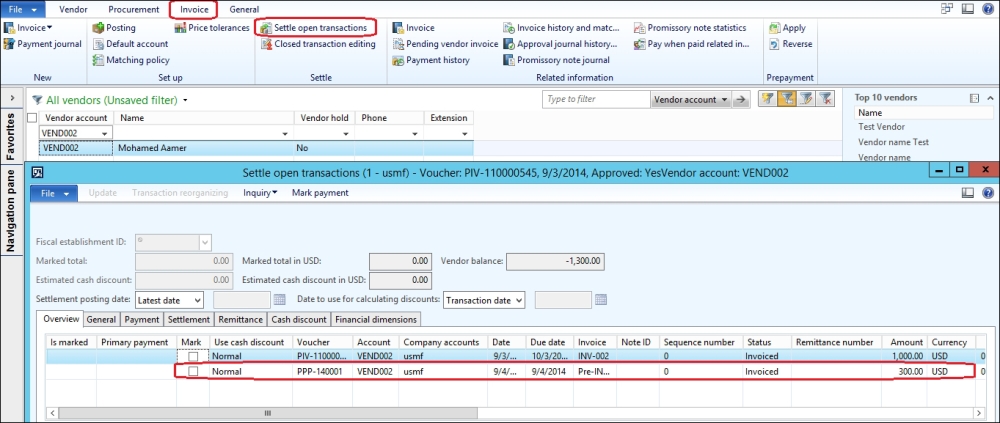
The prepayment invoice is ready to be paid; in order to perform a vendor payment transaction, navigate to Accounts Payable | Journals | Payments | Payment journals, create a new journal number, and then go to Lines. Select the vendor code and then go to Functions | Settlement. The following screenshot illustrates the journal and its line along with the settlement access path:
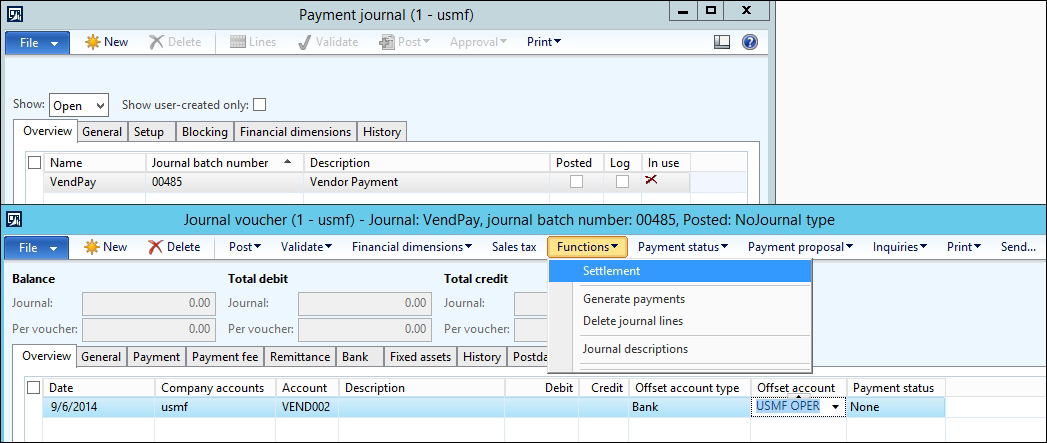
As shown in the following screenshot, in the Settle open transactions form, mark the invoice that will be paid and close the form:

The amount will be automatically populated on the voucher line on the debit side; validate and post the payment transactions. In this transaction, the vendor invoice has been settled against payment transactions and moved to closed transactions, as shown in the following screenshot:

The financial entry is automatically generated as follows:
- Dr. Vendor balance
- Cr. Bank account
In order to access closed transactions, navigate to Accounts Payable | Common | Vendors | All vendors; select a particular vendor and then navigate to Invoice | Closed transaction editing. The following screenshot shows the payment and the settled invoice against it:
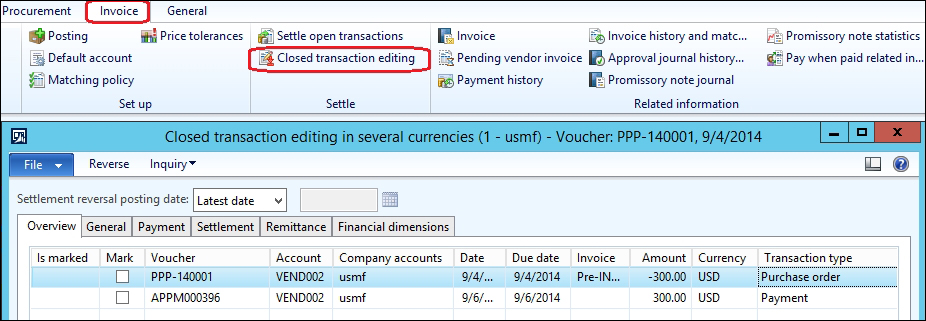
Then, post the purchase order invoice and consider the prepayment amount by applying the prepayment on the final vendor invoice in order to get the realistic vendor liability; there are two scenarios here: apply the prepayment before a post-purchase order invoice or after posting the vendor invoice.
The following screenshot illustrates the prepayment application process before posting the purchase order invoice; navigate to Accounts Payable | Common | Purchase Orders | All purchase orders, select the purchase order that needs to be invoiced, go to the Invoice ribbon, and select Invoice:

The vendor invoice form will open up as shown in the following screenshot; enter the invoice number and invoice description. To do this, go to Apply prepayment.
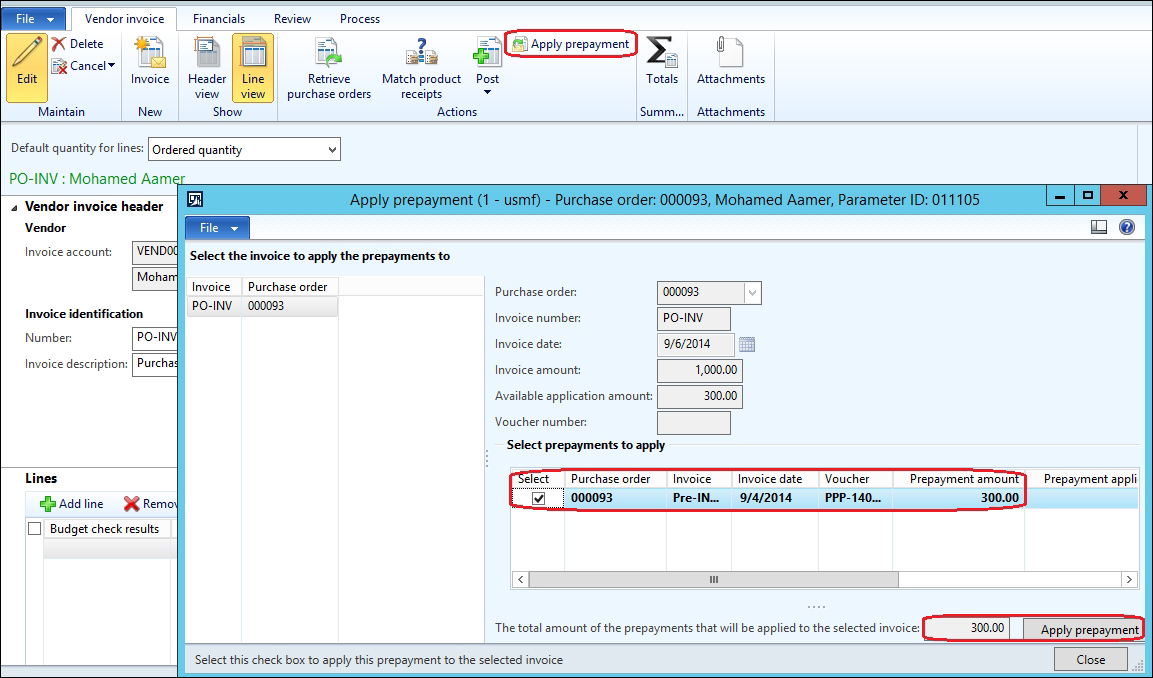
The applied prepayment amount appears in the invoice line with a negative sign; this will lead to the net invoice amount (total invoice amount - prepayment amount). As shown in the following screenshot, the total invoice (1000) minus the prepayment amount (300) equals 700, so the net invoice amount is 700:
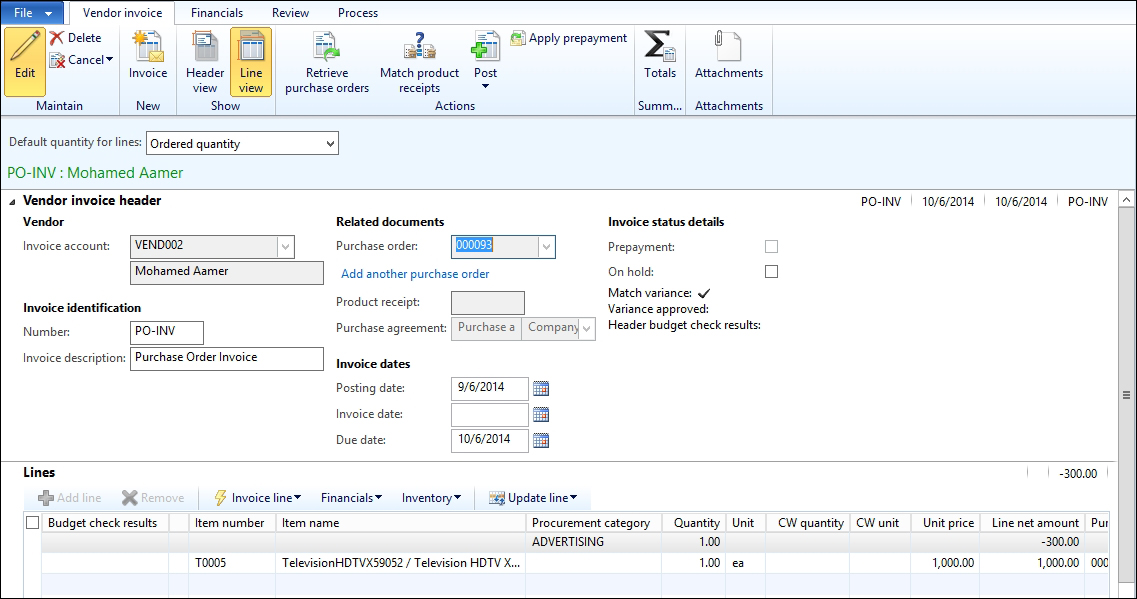
The invoice financial entry for a purchase order invoice that has a prepayment applied is generated; the entry consists of four lines; two lines for the prepayment application and the other two lines for the liability entry, as follows:
The nonpurchase order invoices can be service invoices recorded by the accounting team recording the invoice through Invoice Journal, or the invoices recorded by the concerned departments, where each department will record their expenses invoices through the new vendor invoice form that has been newly introduced in Microsoft Dynamics AX 2012.
The invoice journal is accessed by navigating to Accounts Payable | Journals | Invoices | Invoice journal, as shown in the following screenshot. We can see the invoice journal lines; select the vendor ID and enter the invoice number, the amount in the credit side, and the ledger offset account. The posted Invoice journal generates a vendor liability and ledger entry as well.

The noninventory invoices are mainly used with nonstocked items, where each service item is represented as a specific expense type. This concept is more familiar for departments rather than selecting ledger accounts, as the concerned department that entered the expense invoice does not have experience in accounting, and descriptive expense service items are more familiar with data entry.
In order to access the Open vendor invoice form, navigate to Accounts Payable | Vendor invoices | Open vendor invoices.
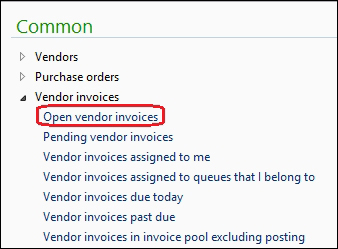
In order to create a new invoice record, navigate to the Invoice ribbon and select Vendor invoice, as shown in the following screenshot:
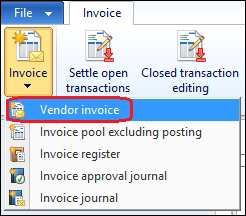
In the vendor invoice form, select the vendor ID and enter the invoice number, description, item number, and then the amount, as shown in the following screenshot:
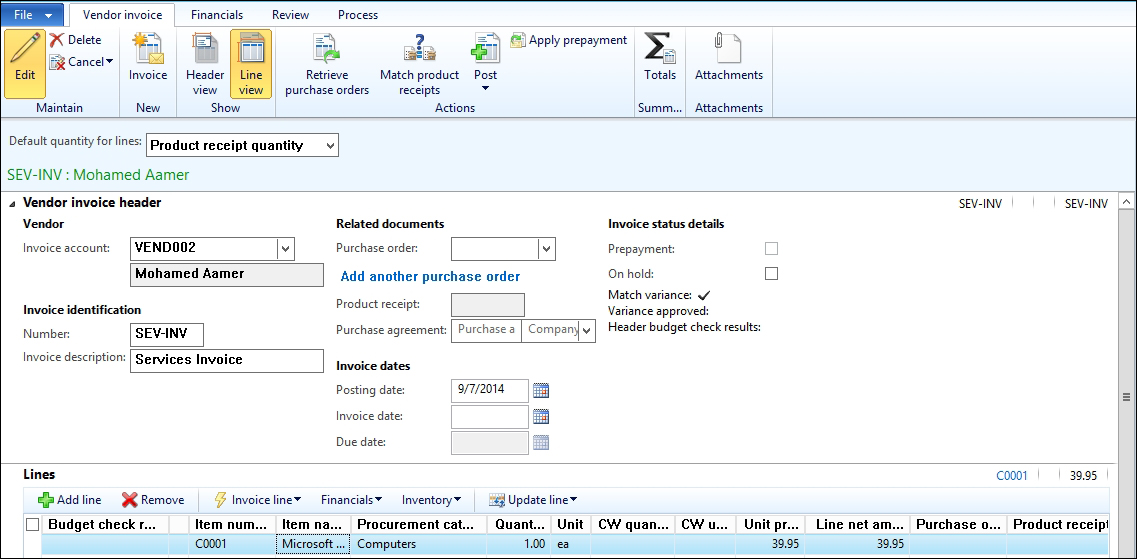
An advance payment is a regular business scenario where vendors are required to pay some amount of money as a down payment regardless of whether there is a purchase order; this might occur with a partner with whom they have regular business. In order to perform an advance payment transaction on Microsoft Dynamics AX 2012, navigate to Accounts Payable | Common | Payments | Payment journal and create a new journal; then move to Lines, enter the vendor ID, and enter the amount, then switch to the Payment tab and check the Mark prepayment journal voucher checkbox.
After this, the default posting profile value to the prepayment posting profile will be changed, as shown in the following screenshot:
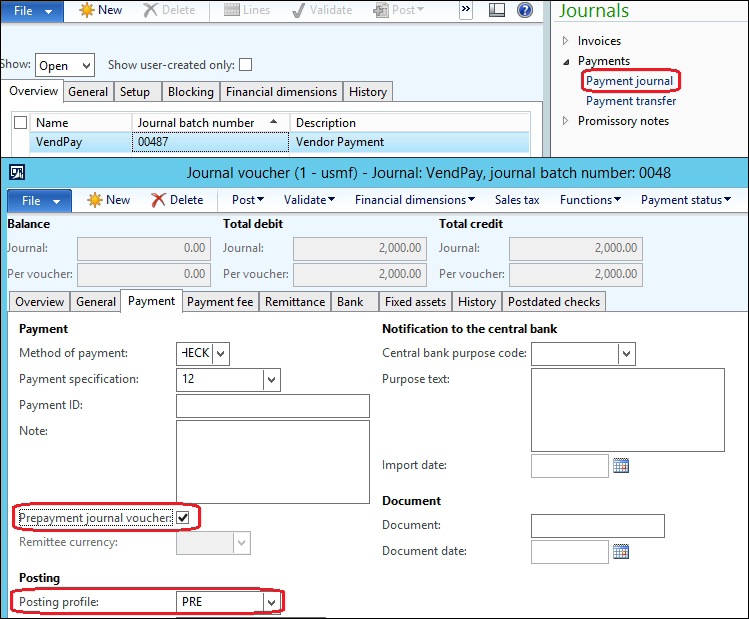
The prepayment posting profile is created under Accounts payable posting profile. Under Accounts payable parameters | Ledger and sales tax, assign the prepayment posting profile.
A settlement is an accounting transaction that occurs on accounts payable, accounts receivables, and general ledger. This transaction is used mainly to settle vendor invoices against vendor payments or advance payments.

It is necessary to classify posting profiles of the vendor and customer in the opening balance as it will affect the settlement process.
The settlement transaction affects vendor and customer balances, and it is reported in the vendor or customer statement report that identifies the following:
- The vendor
- The open (unsettled) invoice and payments
- The closed (settled) invoice and payments
- The vendor balance
A settlement transaction can occur during a payment or collection transaction if the accountant marks the invoice that will be paid or collected. On the other hand, the settlement can be performed at the vendor or customer level, and these transactions can be unsettled.
The settlement transaction should take into consideration the currency as it can be performed in the company's home currency by an equivalent amount, which is calculated based on the currency exchange rate, or it can be settled in the same currency of the invoice by identifying the currency in the payment process.
A vendor settlement in Microsoft Dynamics AX is a transaction that occurs to settle vendor advance payments against vendor invoices on a monthly basis.
Vendor settlements have the following effects:
- The first one is at the vendor level, which occurs when the vendor transaction closes
- The second is the financial entry, which occurs only if the posting profile of the advance payment and invoice are different
Here, I will illustrate the mechanism of vendor advance payment, invoices, and vendor settlement financial entries:
- The vendor advance payment posting profile is advanced, and the financial entry will be:
- Dr. Advances to vendor 1200 EGP
- Cr. Bank 1200 EGP
- Open transactions: 1200 EGP advance payment
- The vendor invoice posting profile is General, and the financial entry is:
- Dr. Expense 1000 EGP
- Cr. Payables 1000 EGP
- Open transactions: 1200 EGP advance payment and 1000 EGP vendor invoice
- The vendor settlement is as follows:
- Dr. Payables 1000 EGP
- Cr. Advances to vendor 1000 EGP
- Open transactions: 200 EGP advance payment
- Closed transactions: 1000 EGP advance payment and 1000 EGP vendor invoice
If the posting profiles of the advance payment and invoicing are different, a settlement financial entry will be created.
